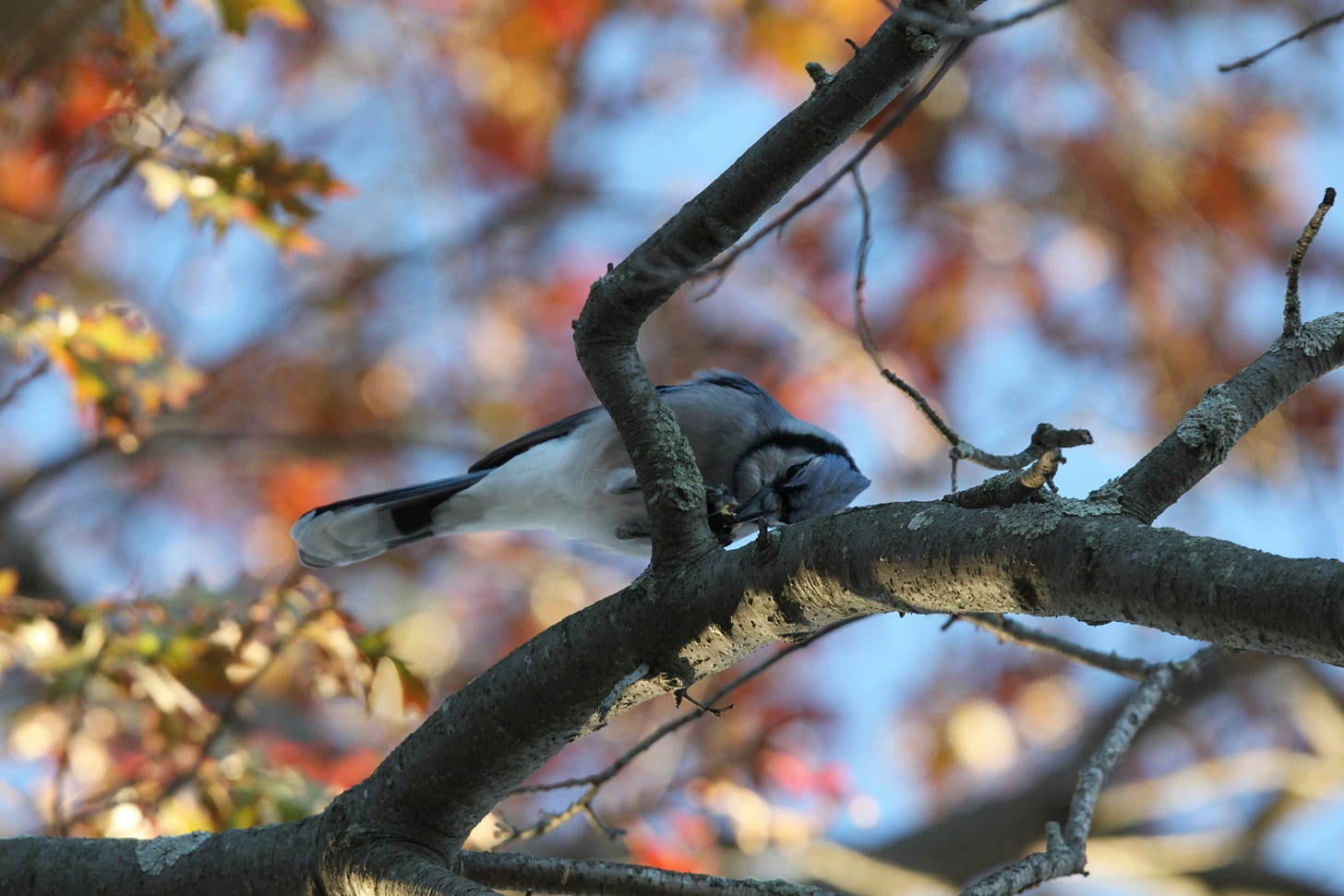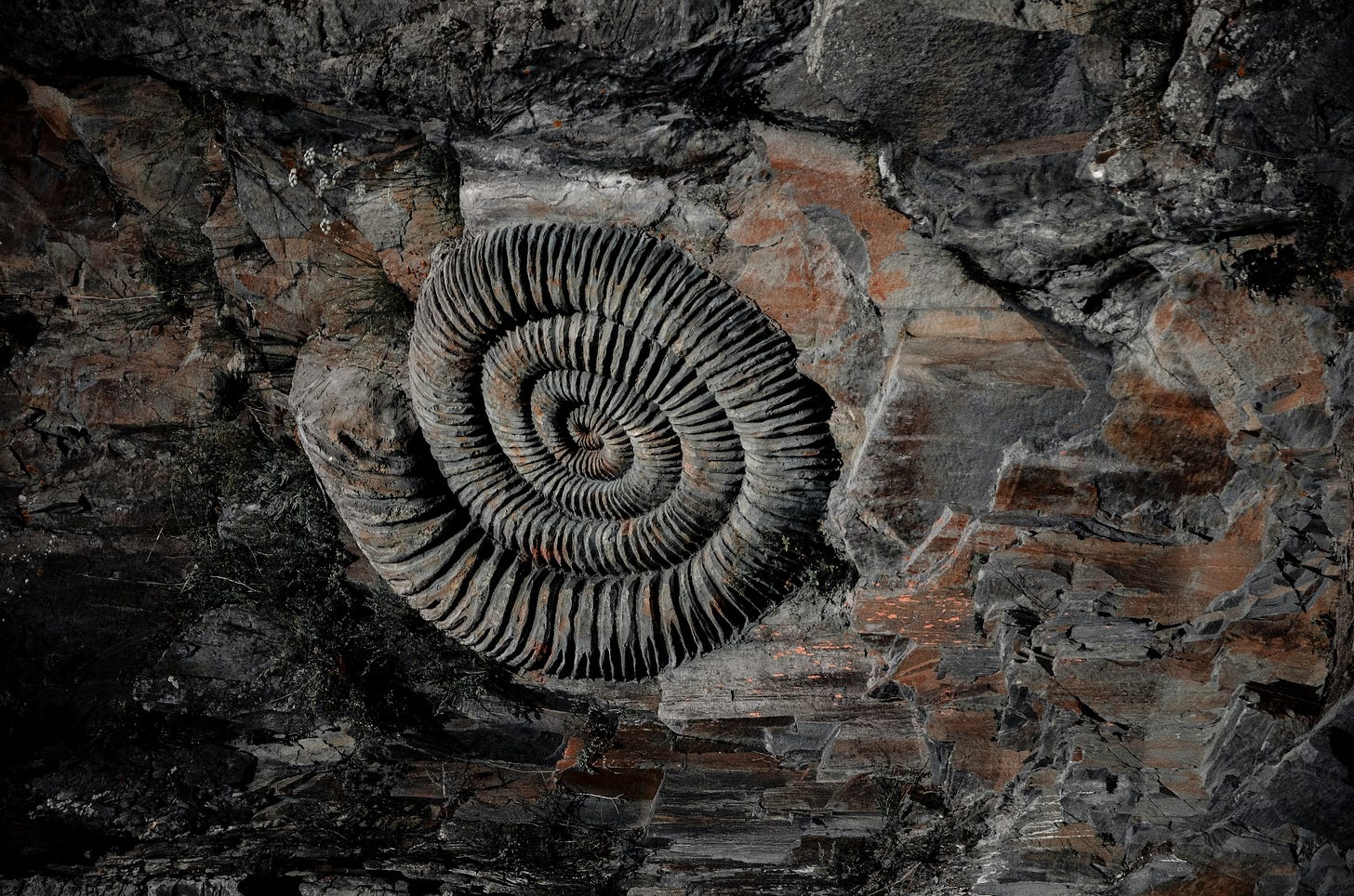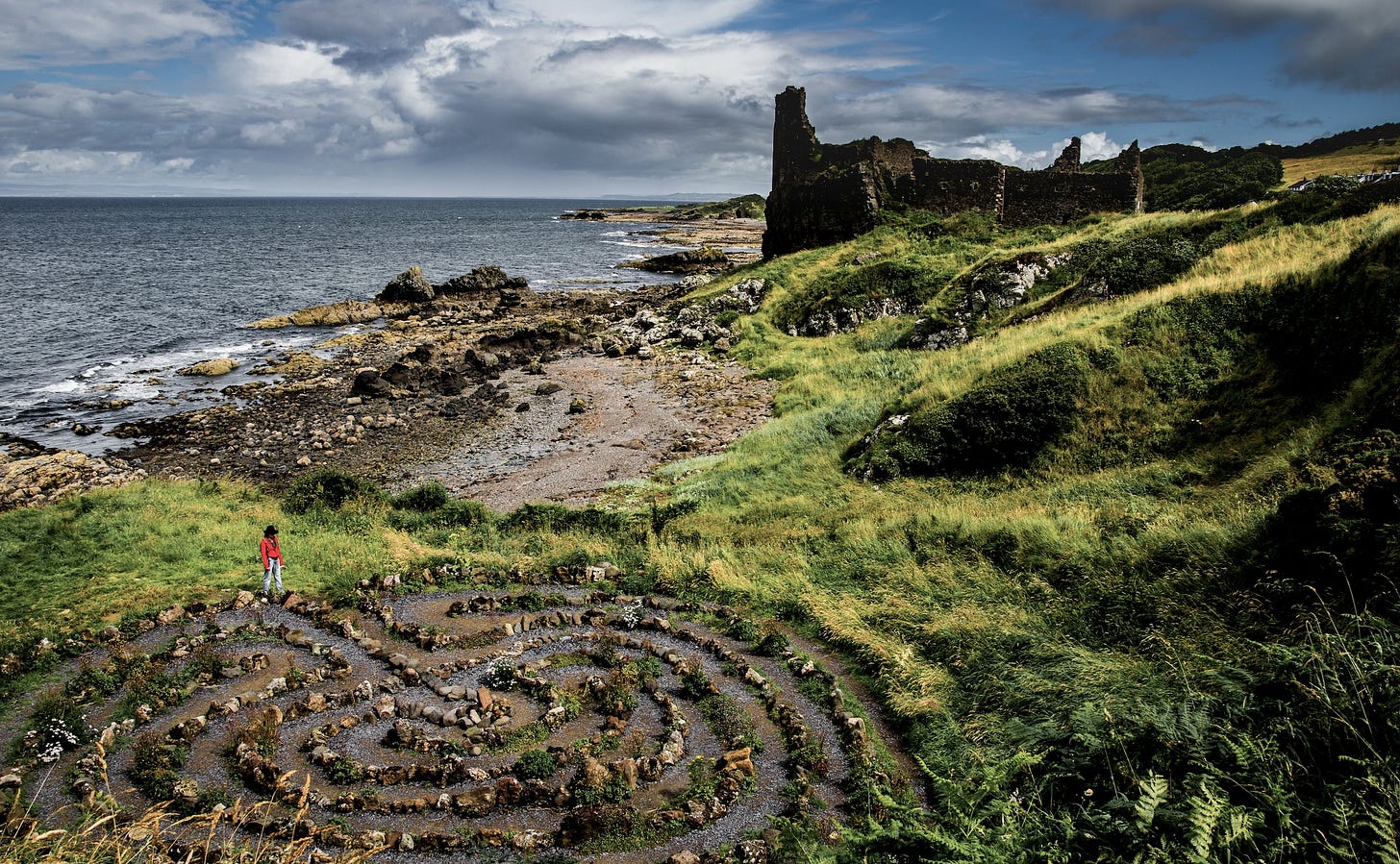Wanderer, there is no path,
the path is made by walking.
〰 Antonio Machado 〰
The Intellect’s Hunger for Knowing
It just really struck me how unexpected it was, to me,
that these wonderful things could coexist with these awful things.
〰 Rebecca Fogg 〰
Talk therapy is overrated. Pouring our hurt out into therapists’ wells, couched in empathetic listening, can exhaust a heavy heart if it leaves the burden of trauma untouched.
Turning away from all the talking, we plant high hopes on somatic experiencing, on promises to loosen the roots of trauma from the sacral bones, and nourish the interstitial fabric of human Consciousness.
But is this enough to sustain the wounded traveller along the length and breadth of the healing journey?
In her book Beautiful Trauma, Rebecca Fogg describes her journey of recovery from a freak accident one fatal night in her New York apartment. In her story, trauma strikes ~ in the original sense of the word ~ as a severe injury, a physical wound.
In the accident, Fogg’s hand is almost amputated by an exploding cistern in her bathroom. The surgeons rebuild attachments between bones and tissues of hand and arm in a complicated operation and medical aftercare. The question whether the stitched together limb will recover its healthy range of uses remains open.
In the wake of the trauma, Fogg develops an obsession with learning all about the anatomy and physiology of the human hand. In addition to physiotherapy, and diligent daily practice of prescribed exercises, she absorbs all available scientific information about the nervous system, especially how nerves grow and regenerate themselves.
This story of recovery demonstrates how mental focus and physical discipline work together ~ following state of the art surgery ~ to support the self-healing organism in her efforts to regain her functions after a catastrophic trauma.
In other words, healing is not a matter of mind or body. The synergy of all Faculties can achieve near miraculous results.
The Intellect is the Faculty of IHC which has made great contributions to the history of science. In fact, science sometimes gives the impression as if the Intellect is the only Faculty it needs, the only one humans can rely on, the only one that leads to objective facts and truth, to solutions of all human problems.
This reduction and singling out of the Intellect has also brought backlashes, rejecting the rational Faculty, and hailing alternative ‘holistic’ approaches as the road to the ‘holy grail of healing’.
The truth is, holism and throwing out certain Faculties in favour of others don’t go together. Wholeness can only thrive while recognising the gifts, contributions, and interactions of all Faculties.
In Western science, the Intellect’s overrated position is based on an erroneous translation of René Descartes’ famous words cogito ergo sum ~ translated as I think therefore I am.
But cogito ~ does it really mean the same as I think?
Cogitation [from Latin co = together + agitare = to shake, move, impel, put in constant motion] is literally a collaboration towards vigorous motion.
Used since the early days of recorded English in the sense of thought, idea, notion, act of thinking, earnest reflection, consideration, cogitation has never been an activity of the Intellect alone.
Neither was thinking…
Think [cognate with German denken] is listed in the Century Dictionary with at least 11 different meanings: (1) to judge, say to oneself mentally, form a judgement or conception; (2) to imagine, form a mental image; (3) to cognise, apprehend, grasp intellectually, exercise the intellect, perceive; (4) to intend, mean, have in mind, contemplate; (5) to hold as belief or opinion; (6) to feel, have a feeling for, to have a liking or fondness of; (7) to modify at will, to devise, plan; (8) to solve by process of thought; (9) to attend, focus the mind on; (10) to long for, yearn, (11) to reason.
Thinking used to be considered a mental activity reserved exclusively for men. Gotthold Ephraim Lessing (German philosopher 1729-1781) wrote: “How can a man love a thing that wants to think in defiance of him? A dame who thinks is as disgusting as a man who wears makeup.”
The Chattering Acknow Gatherer
Perhaps ‘rewilding’ was, by its very nature, a slippery, unpredictable concept.
〰 Isabella Tree 〰
Within the organism of human Consciousness the Intellect is primarily the gatherer and processor of acts of knowing (Acknows ~ see Chapter 16).
The trouble is, between gathering and processing there is always a time lag.
The Inner Expert ~ title of the Intellect ~ gathers Acknows, like the Eurasian jay collects acorns.
“A single jay can plant over 7,500 acorns in four weeks, living up to its Latin name, Garrulus glandarius, ‘the chattering acorn-gatherer’,” Isabella Tree shares in her book Wilding.
“It buries each acorn separately,… June is when the jays start looking for the seedlings to feed their young. They are interested not in the seedling itself but in its cotyledons – the fat, primal leaves containing stored food reserves from the seed that most plants depend on for their initial burst of energy to grow.”
Like the jay burying acorns, the Inner Expert stashes away Acknows for future use and nourishment.
Unlike the jay (or maybe not, I’m no expert on jays!), the internal ‘Chattering Acknow Gatherer’ in IHC is often systematic in the arrangement of his stashed away Acknows. He doesn’t just collect [from Latin com = together + legere = to gather] bytes of knowledge at random.
The Inner Expert arranges his collections in spirals; that’s how living beings grows naturally. He coils [from Latin com + legere = to gather] Acknows, arranging them in rings around each other.
The Migrating Intellect
Though the birds have traveled all night and are surely weary,
they can't bring themselves to land:
their restlessness is too strong, the urge to keep moving too great.
〰 Brenda Miller 〰
The Inner Expert is driven by a natural internal restlessness, reminiscent of migratory birds. The German term for avian restlessness during migration ~ Zugunruhe ~ has been adopted in English, and now pops up in essays and book titles.
“When migratory birds are held in captivity, they hop about, flutter their wings and flit from perch to perch just as birds of the same species are migrating in the wild. The caged birds ‘know’ they should be travelling too. This migratory restlessness, or Zugunruhe, was first described by Johann Andreas Naumann (1744 - 1826)” William Fiennes.
In her essay Do You Have ZUGUNRUHE? Sarah Seidelmann explores symptoms of migratory restlessness in humans. “It can start with a discomfort that begins to rise, an urge telling you that, like the birds, you just gotta fly … or be doomed to a lifetime of nervousness and chronic sleep disruption.”
While this restless can show up in all Faculties, the Intellect is particularly prone to a familiar form of expression. Meditation teachers call it monkey mind.
The monkey mind ~ or mind monkey ~ goes back to the Chinese word 心 猿 xīn yuán = heart ape.
Chinese 心 xīn refers to the heart and mind, based on the ancient Chinese belief that the heart is the centre of human cognition.
“In early Chinese thought, xin, which refers to the physical heart, is regarded as the site of both cognitive and affective activities. It is translated sometimes as ‘heart’, sometimes as ‘mind’, and in recent literature often as ‘heart/mind’ to highlight the different aspects of the activities of xin. Xin can form certain directions, which can take the form of long term goals in life or more specific intentions.” (Stanford Encyclopedia of Philosophy)
What contemporary Buddhist teachers call ‘monkey mind’ is associated with mental chattering, or the undisciplined activities of intellectual Faculty, which apparently can get easily distracted.
While this mental restlessness can be distracting, it is not necessarily good or bad. What if it simply expresses the indigenous knowledge of the Inner Expert to signal an urge to move on ~ a migratory restlessness?
What if spontaneous thoughts popping up on the radar of the Inner Expert in moments of stillness are related to bites of knowledge gathered earlier, buried in the inner soil, now sprouting and stirring to serve as nourishment for the journey ahead?
What if the agitation of the Inner Expert is a natural urge to process and digest information from experiences which have not yet been assimilated? What if the Intellect needs to move around the evolutionary spiral of being, again and again, to grasp the meaning of it all?
No Pure Reason
We would know a great lot so much better,
if we did not wish to aken it too closely.
〰 Johann Wolfgang Goethe 〰
In the late 18th century, the German philosopher Immanuel Kant (1724 - 1804) wrote his seminal work Critique of Pure Reason. In this philosophical treatise Kant went into some length and depth to explore and offer proof of his akennings that pure reason doesn’t exist.
“The order and regular patterns of appearances, which we call nature, we place into it ourselves,” according to Kant, “and we would not be able to find them within nature either, had we, or the nature of our mind, not embedded them into it originally.”
Pure reason implies a theoretical possibility of reasoning without prior knowledge ~ an intellectual perception without experience involving the other Faculties.
Kant basically managed to show and explain that the Intellect doesn’t function without Instinct, Imagination, Intuition, Inspiration, Soul, Will and Body.
Despite the profound influence and overwhelming impact of Kant’s work in the field of philosophy, the basic interpretation of the Intellect as a superior Faculty of the human mind remained unchallenged for another couple of centuries, supporting the monopoly of so-called physical sciences.
When quantum physicists discovered that matter doesn’t exist and objectivity is a figment of the imagination because the observer always impacts what they are observing, this monopoly received a fatal blow. Or so any logically thinking human would have thought.
And yet, defying all logic and evidence, the anthropocentric paradigm is clinging to the thesis that logic is superior to the non-logical Faculties. Following in the footsteps of the ‘Age of Reason’ (aka enlightenment period, late 17th to late 18th century) and the ‘Golden Age of Quantum Physics’ (20th century) we are now living in the ‘Digital Age’ (aka ‘Age of Information Technology’, beginning in the mid 20th century).
In the tried and tested style of all innovations, the proponents of digital technology promise a better future, unprecedented achievements and the kind of progress, which philosophers of the Enlightenment age and quantum physicists have already refuted.
Developers and disciples of the Digital Age lean heavily on pure logic. The Intellect is, yet again, summoned to carry the main burden of what the vital organs of the living organism of human Consciousness are made to share.
The technologicians of AI may have taken to heart the message of quantum physics that ‘matter doesn’t exist’. They may have drawn the erroneous conclusion that ‘therefore virtual reality is all we need’ (turning blind and deaf to the fact that virtual and material reality exist on analogous planes).
Ignoring Kant’s message that pure logic doesn’t exist, some technologicians are currently attempting to elevate logic to a god-like status.
Logic and reason, the primary attributes of the Intellect, are declared to be divine ~ virtually ~ by virtue of some technological applications and appliances.
Real humans have the power to apply this new religion of digital technology by handing over their own innate functions of the natural Faculties of their living organism of individual human Consciousness to a manmade machine.
The age of digital technology is taking place in synchrony with what Jean Gebser called the degenerative phase of the mental structure of Consciousness. This is a late stage of the anthropocentric era, clinging to the doctrine of ‘salvation by logic’.
Jean Gebser’s degenerative phase of the mental structure of consciousness, and the ‘digital age proposing a new Church of AI’ also coincides with a transition from the (in many ways outdated and dying) anthropocentric towards the new symbiocentric era.
Symbiocentric ideas and suggestions herald the generative phase of the diaphanous structure of Consciousness (in Gebser’s language).
Declaring logic as ‘divine’ is of course perfectly reasonable, if all expressions of human Consciousness are regarded as ‘gifts of God’. Picking out ‘Logic’ as a superior Faculty with god-like powers doesn’t change the fact that pure logic doesn’t exist separate from the knowledge and perception of all other Faculties. There is no such thing as ‘pure reason’.
Interstitial Thinking
All thinking happens interstitially ~
between beings, ideas, differences, mythical gradients.
〰 Sophie Strand 〰
The Intellect has been worshipped and given divine privileges for centuries. This apparent blessing turns out to be a curse. The Inner Expert never demanded a superior position. He only tries to do his job, within reason, within his sphere of human Consciousness.
The suppression, repression, and distortion of other Faculties with the explicit aim to serve the rational mind, improve human life, and accelerate our evolution has further weakened the organism of human Consciousness, including the Intellect.
It is not only the functions of the individual Faculties which have suffered. The anthropocentric paradigm ~ while monopolising the Intellect ~ has trained the human mind to focus on results. Every mental activity that appears to contradict, distract or disturb the so-called ‘rational mind’ was, and often still is, dismissed as invalid.
The censorship and discrimination we witness in the outer world has been implemented in the inner world too ~ by ourselves. Especially the expressions of the human Instinct have been consistently suppressed, ridiculed, declared as outdated and ‘irrational’, and attacked with violent measures (as mentioned in Chapters 7, 13 and 15 in reference to emotional suppression).
In their efforts to eradicate the human Instinct, Cartesian ‘enlightened thinkers’ equated the mind with Intellect, while missing the point that the so-called ‘rational mind’ becomes highly irrational, without the essential supportive functions of the other Faculties.
Cogitation is a mental collaboration of all Faculties of Consciousness. When faced with a problem, the entire organism tries to figure out what it means, how to find a solution. While the Intellect is the ‘expert processor’, he draws on the assistance of all Faculties.
Cogitation is a process of churning something over in the mind, which has been interpreted and labelled as ‘thinking’ and assigned to the Intellect alone, for centuries. Western thinkers generally speculate that this happens in the brain. How do they know?
Sophie Strand, writer, poet, essayist on substack and elsewhere, believes that “thinking happens interstitially – between beings, ideas, differences, mythical gradients.”
Interstitial spaces exist not only between things, people, events in the outer world. The inner ecosystem is filled with interstices (spaces in between) too, similar to the physical organism, where interstitial tissue envelops every organ. Mental activities, including thinking, happen in those spaces in between. They are never the isolated act of one Faculty.
The erroneous assumption that the Intellect must figure things out ‘by himself’ ~ because ‘contamination’ or ‘distraction’ or ‘manipulation’ from other Faculties somehow lead to ‘impure reasoning’ ~ has caused so much havoc and confusion in the inner world that humans (mostly Western, white and male) now invest vast amounts of time, money, and mental resources into developing technologies to replace the work of the Intellect altogether.
As a result of this unfortunate misperception, the human Intellect is degenerating even faster, barely surviving in the afterglow of his former glory.
Thinking in Circles
The end of all our exploring
Will be to arrive where we started
And know the place for the first time.
〰 T. S. Eliot 〰
Human storytelling ~ from the mythology of Ancient China, Africa and the Americas, via the epics of Ancient Greece, to the contemporary novels of the Harry Potter series ~ is composed in circular patterns.
Over many years of research, British anthropologist Mary Douglas (1921–2007) discovered that the circular narrative structure reflects a fundamental organisation of human thinking.
“Those ancient peoples whose writings puzzle us have struggled hard against intellectual confusion by establishing their own foundations of knowledge.” Douglas argues in her book Thinking in Circles.
The natural movement of thinking in ‘rings within rings’ is reflected in the so-called homing instinct ~ the innate ability of birds, snails, and many other animals to return to their territory, sometimes from great distances. According to Mary Douglas, this homing instinct is also one of the basic mental resources of humans.
“It is worth reflecting more on the gratification of going home, and the balance between the joy of exploring and the joy of returning. The traveler sets out with a destination in mind, reaches it, turns around, and travels back the same route to the beginning.”
Apart from the joy of exploring, and the gratification of returning to a place that feels like home, people can also lose their home. Wars, natural disasters, economic hardship may lead to a diaspora of people from their homeland.
In search of home, humans can also get lost in the unfathomable wilderness of their own inner world. This is where the ‘homing instinct’ ~ a natural innate feature of the human organism of Consciousness ~ can help.
Although homing is probably not an exclusive talent of the Intellect, but rather relying on contributions of several Faculties, we are all familiar with the phenomenon of ‘thinking in circles’. When confronted with a problem, the mind becomes restless. The thinking process accelerates. Thoughts are known for their tendency to ‘race’.
In such moments, the whole organism is focused on one goal: To return home. In this case, home is not a physical place. It is an inner space where the mind can rest, where the soul is at peace, where the living being can be oneself.
Home is a place of safety and familiarity. In the mental realm of the Intellect we experience this ‘homeyness’ as a sense of coherence.
The Western mind lost its sense of home when indigeneity was driven out of Europe by the crusades of Christianity. These crusades continued with the above mentioned Ages of Reason and Science, and the colonisation of countries all over the world, mostly by Western Europeans.
As a result of this loss of home, the Inner Expert has been overburdened with tasks which are beyond his capacity and charged with responsibilities which were never designed to be fulfilled by him alone.
In indigenous structures of human living every voice is heard. Every member of the clan is valued. The council of elders is not fixed but interchangeable. Human culture is not separate from nature but living in respect for and constant exchange with all living beings populating the surrounding landscape, for mutual benefit.
Being embedded in the natural order has a profound impact on the inner world of humans, sustaining all Faculties in their healthy functioning. Thinking, the language of the Intellect, is not expressed through words, statements, commands, digital messages or blog posts. The Intellect (like all Faculties) speaks in the language of life itself.
In his book Indigenialität (Indigeniality) German biologist and philosopher Andreas Weber writes about the colonisation of our thinking. If we want to turn our world into a life-giving space, Weber suggests, that we need to end this ‘internal colonialism’.
“We must decolonise ourselves, our soul, our thinking. We must rediscover the indigeniality in ourselves, invite it, trust it, We must become wild again — wild does not mean without rules (as Hobbes assumed), but open for exchange in a world of reciprocity.”
Into the Labyrinth of the Self-Restoring Intellect
Through the unknown, remembered gate
When the last of earth left to discover
Is that which was the beginning.
〰 T. S. Eliot 〰
The diagram of this ‘Map of the Intellect’ pulled out of the Noctarine Web of Consciousness looks deceptively similar to the ‘Map of the Body’ we explored in the last chapter. On closer inspection you’ll notice that this diagram is outlined in the colour of the Intellect, and the names of the nodes follow the track of the Inner Expert.
To explore depleted zones of your inner ecosystem with the Inner Expert as your guide follow the instructions in the attached download.











Hi Veronika,
“But is this enough to sustain the wounded traveller along the length and breadth of the healing journey?
I can totally relate to the ‘heavy heart’ aspect. When John was diagnosed — we had recently done the tree change, had my mother with us etc. I was totally overwhelmed — the therapist was ill equipped, arguing with me that I should put my mother into aged care to alleviate my burden. Needless to say, I didn’t last long with a therapist unable to listen.
I had previously visited a therapist who helped me (in my mid 40s) re a workplace situation which triggered a childhood trauma. I went back to her after John died, though she wasn’t able to help, (by her own admission) — other to say she would “want someone like me”, if she had a terminal illness and wanted to die at home. So, my time with therapists was done.
My own inner work started with utilising my intellect — study being a space of comfort and curiosity for me, and affording a sense of control in relation to deconstructing literature etc. Coupled with meditation and spiritual seeking, the (unexpected) gift was the opening guidance to the other realm of existence (the team). For that I am grateful as it coincided with my growing discomfort in the mainstream-ness and egotism prevalent in both mainstream and spiritual and healing circles. And I had enough of giving my power over to others — the old trauma response. Though, I was also a little bemused with myself, that I was edging away from my intellect — the more the portals opened to the team. Until I understood that it wasn’t an either, or, choice. I just needed to go in with an openness and willingness to challenge some of my own beliefs — and trust. The intellect lead me there ... and back to nature. And nature expanded the portals that had opened in meditation. My body receives and my mind gives me the language to share the experience of recovery — and healing. My enthusiasm for learning continues, such is creativity and curiosity. A spiral.
Thank you so much for the clarification and knowledge you share. Your wisdom brings further assurance and empowerment to self.
“In other words, healing is not a matter of mind or body. The synergy of all Faculties can achieve near miraculous results.”
“Wholeness can only thrive while recognising the gifts, contributions, and interactions of all Faculties.”
The questions you pose around our ‘monkey mind’ are fabulous. The Chinese xin, how interesting. And ...
“What if the Intellect needs to move around the evolutionary spiral of being, again and again, to grasp the meaning of it all?”
“Kant basically managed to show and explain that the Intellect doesn’t function without Instinct, Imagination, Intuition, Inspiration, Soul, Will and Body”
“And yet, defying all logic and evidence, the anthropocentric paradigm is clinging to the thesis that logic is superior to the non-logical Faculties.”
“Developers and disciples of the Digital Age lean heavily on pure logic. The Intellect is, yet again, summoned to carry the main burden of what the vital organs of the living organism of human Consciousness are made to share.”
“ ... this new religion of digital technology ... this is a late stage of the anthropocentric era, clinging to the doctrine of ‘salvation by logic’.
I am thoroughly enjoying the journey home. Thank you for enriching it — your knowledge and work in weaving it together what you offer us. A gift
“As a result of this loss of home, the Inner Expert has been overburdened with tasks which are beyond his capacity and charged with responsibilities which were never designed to be fulfilled by him alone.”
Currently revisiting Ch 15 — I keep coming back, so much to consider learn, through all faculties ... and realms of being, with the team. Thank you. 😊 🙏 🌀 🌱 💜
Veronika!
There’s so much here I need to just keep reading and reading . This is such a gift. I love reading the comments. Totally agree healing is making whole. As a physiotherapist and a bodyworker professionally this all collides beyond just thinking. So much is connecting here and I love your diagram and your download. I love how you reason through all of this. You share resources I immediately want to dive into. Thank you for the opportunity to practically apply it. It’s definitely a collision on a wild path. A labyrinth. A spiral. A widening circle.
The Noctarine!
Thank you for being here. Living into the questions. Your writing takes me to places way beyond thinking. 🙏❤️